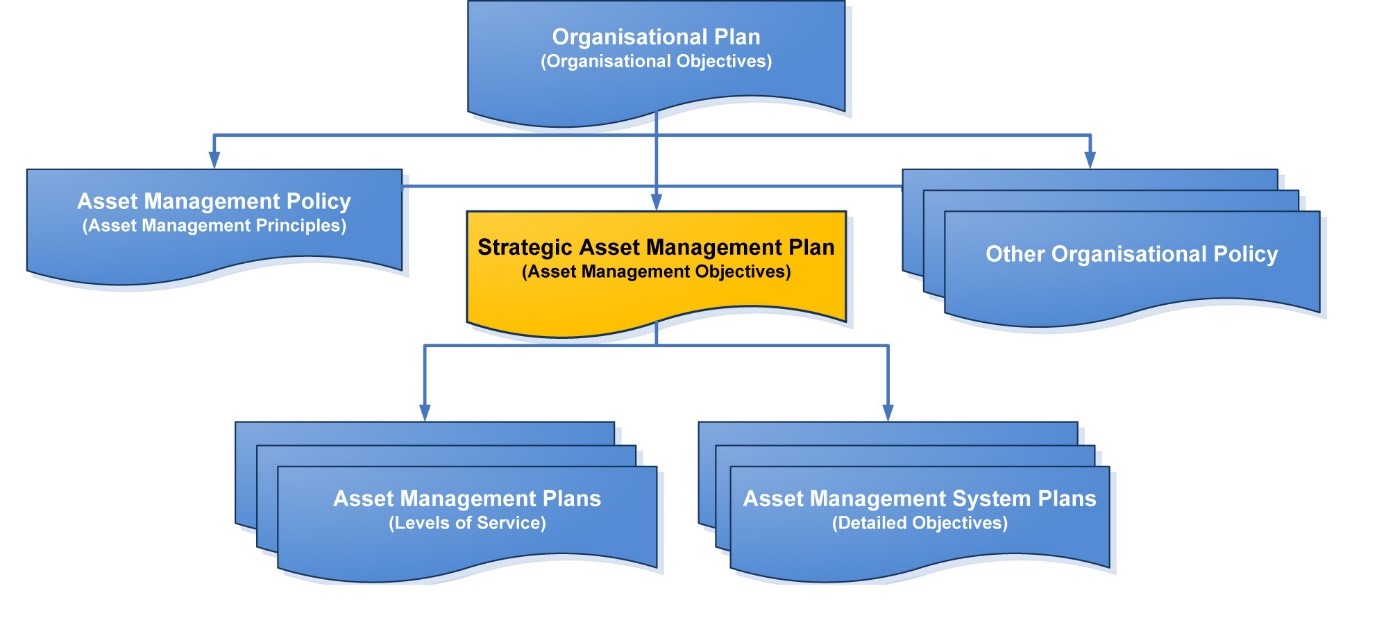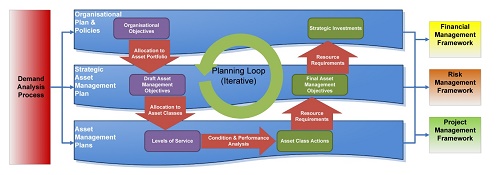ABSTRACT
In view of the lower levels of prescription (and hence increased uncertainty) given in ISO 55000 regarding the construction of a Strategic Asset Management Plan, advice is offered regarding constructing and disseminating this important document – its definition, purpose, role in the asset management documentation hierarchy, compliance with ISO requirements, generation and alignment of objectives and strategic initiatives, its customers and its presentation.
INTRODUCTION
One of the most common questions we hear in relation to asset management is some variation of ‘What should my Strategic Asset Management Plan (SAMP) look like?’ We used to hear this in regards to asset management strategies under PAS 55, but the greater visibility and lower levels of prescription in ISO 55000 have clearly created uncertainty regarding the practicalities of how to build this important document. While there is no single ‘right way’ to structure a SAMP, we would like to share our thoughts on how to create a good one that will work for your business.

DOCUMENT PURPOSE
Let’s start with the definition of the SAMP, as drawn from ISO 55000:
Documented information that specifies how organisational objectives are to be converted into asset management objectives, the approach for developing asset management plans, and the role of the asset management system in supporting achievement of the asset management objectives.
This gives us a broad flavour of the document, clearly showing that its role is to capture asset management objectives that link the organisational objectives (typically part of the organisational, corporate or business plan) to lower level plans. The SAMP therefore has a pivotal role in the asset management document hierarchy, as illustrated in Figure 1.
In this role, the content of the SAMP must be driven by the larger asset management planning process. Without going into excessive detail, an ISO 55001 compliant planning process is illustrated in Figure 2.

We see here how an iterative planning process will generate asset management objectives that are aligned with the organisational objectives, informed by demand information (i.e. stakeholder wants and needs) and consistent with the condition, performance and capability of both the asset portfolio and the asset management system. What, however, is an asset management objective? These are the ‘results to be achieved’ or the aims, goals or targets for asset management. They address both the assets and the tools for managing them (i.e. the asset management system) and examples might include:
- Achieve 94% availability in the process plant,
- Expand capacity to 2.4 million units per annum, or
- Introduce a new ERP system to support expansion to multi-site operations.
As can be seen from the examples, these objectives reflect the outcomes that asset management should produce rather than the methods for achieving them. They therefore need to be supported with appropriate high level actions (which we like to call ‘strategic initiatives’) that will deliver them. As with any actions, good strategic initiatives will be adequately resourced with clear timelines, measures of success and accountabilities. These high level initiatives may, however, be delivered either as a project in their own right, or by allocating appropriate levels of service and detailed objectives to subordinate plans, as illustrated in Figure 2. Possible initiatives (illustrative only – initiatives do not need to map directly to a single objective) matched to the objectives given above might be –
- Apply ‘Lean’ maintenance to the process plant to increase availability by 10% by the end of the year (GM Reliability)
- Commission Train 3 by the end of 3rd quarter (GM Expansion Projects)
- Implement SAP across the business by the end of the year (Chief Information Officer)
When combined with the asset management objectives, the strategic initiatives provide the required direction for lower level planning. These are, however, the deliverables from the planning process and the SAMP is merely the method for documenting these. The quality of the planning process will determine whether the asset management objectives and strategic initiatives are appropriate, achievable and accomplished. The quality of the SAMP will determine whether these objectives and initiatives can be communicated to the people who need to use them. Consequently, the SAMP will be ‘good’ if it is a successful communication tool that delivers the right information to the right people at the right time. Let’s look at each of these individually.
Having the ‘right information’ obviously relates to appropriate, achievable, asset management objectives, and is mostly dependent on carving out an appropriate role for asset management planning within the organisation’s strategic planning hierarchy. This can be a challenge, since most organisations have been undertaking strategic planning for a long time, but have only recently tried to introduce formal asset management planning. Consequently, we often see organisations where the organisational plan covers the key asset investments (often with inadequate planning), and implementing the SAMP is merely a ‘nice to have’.
While the ‘right people’ will clearly vary with organisational structure the customers for the SAMP usually aren’t in the asset management area, since these people already know what is happening in the area. The most common customers are –
- Executives, who need to understand what the assets (and the asset management system) are going to deliver, sign off on the associated resources and track progress.
- Technical managers, who need to write the detailed asset management plans for their specific assets.
- Other managers (administration, finance, human resources, learning and development, procurement and project), who need to understand the asset management system and what they need to deliver to support it.
Delivering the information at the ‘right time’ is more about the method of delivery, since the SAMP is always there waiting. The key is to ensure that the document is presented in a way that lets the ‘right people’ get the information they need, which implies a short, readable document that clearly lays out the asset management objectives and strategic initiatives with enough background to understand why they are important and appropriate.
COMPLIANCE REQUIREMENTS AND GUIDANCE
Now that we understand its basic purpose we should attempt to understand the ISO 55001 requirements for a compliant SAMP. Surprisingly, we find that the standard does not actually require very much of the SAMP at all. In fact, it only specifically requires inclusion of the asset management objectives and documentation of the role of the asset management system in delivering those objectives. There are a few implied requirements such as Clause 4.3, which requires the scope of the asset management system to be aligned with the SAMP and therefore implies that the SAMP must provide a basis for this, and Clause 6.2.2, which similarly implies the SAMP must provide a basis for establishing the subordinate asset management plans required to achieve the asset management objectives. Overall, however, there is little guidance on the content of a SAMP within ISO 55001.
ISO 55002 provides guidance on implementing ISO 55001, and makes the following recommendations regarding the structure and content of the SAMP.
- The SAMP should document the approach to implementing the principles laid out in the asset management policy.
- The SAMP should document both the framework for achieving the asset management objectives and their relationship to the organisational objectives.
- Asset management documentation (including the SAMP) should be scaled to match the organisational size and complexity (from a single document combining the organisational plan, SAMP and subordinate plans to separate documents with additional layers of plans below the SAMP).
- The SAMP should include a statement of stakeholder needs.
- The SAMP should include a statement of scope for the asset management system.
- The SAMP could include the asset management policy if desired.
There are also a few other items that are required by ISO 55001 as documented information and are therefore candidates for inclusion in the SAMP, viz. –
- The method and criteria for decision making and prioritising.
- The processes and methods for managing assets over their life cycles.
- The actions to be taken, including resources, responsibilities, timeframes and evaluation methods.
- The planning time horizons and review periods.
- The implications of the plans.
- Actions to address risks and opportunities.
It is obvious from this limited guidance why confusion has arisen regarding the requirements around the SAMP. Taken all together, the ISO standards leave a great deal of latitude regarding the content and structure of this document. In fact, you don’t even need to call it a SAMP – you can call it an asset management strategy or whatever else you like.
SOME RECOMMENDATIONS
Taking into account all of the foregoing, we believe that a ‘good’ SAMP has the following key characteristics –
- Driven by an asset management planning process that is fully integrated within strategic planning
- Has a clear role with broad and consistent understanding across the organisation
- Addresses both asset and asset management system requirements
- States the asset management objectives with sufficient background to promote understanding, acceptance and achievement
- Describes the strategic initiatives with sufficient background to promote understanding, acceptance and achievement
- Uses appendices and references to other documents to keep the document short
- Uses graphics and tables to enhance understanding
- References, but does not include, on-going process information used to generate the plan
In terms of content, we suggest starting with the following and then adapting it to your requirements:
- Executive Summary – key points for senior management.
- Introduction – purpose of the document.
- Asset Management Policy Statement – if included (we would generally recommend not).
-
Organisational Context – enough on the current state of the organisation to allow the reader to understand the priorities – e.g. cost saving, capacity growth or perhaps safety compliance. This would include brief discussion of the following:
- Market position (competitors, demand forecast) o Stakeholder needs (regulators, customers, staff, owners…)
- Asset portfolio (general description and condition)
- Asset management system (general description and condition, including process maturity and workforce competency)
- Asset Management Planning Process – summary of the approach used to develop the SAMP with reference to minutes of meetings or analyses to build confidence in the robustness of the process
- Asset Management Objectives – a statement of the agreed asset management objectives, mapped to the organisational objectives
- Strategic Initiatives – a description of the selected strategic initiatives, including: (tables can be helpful here) –
- Mapping against the asset management objectives
- Targets and measures (including links to levels of service in subordinate plans)
- Relative priorities
- Timeframes
- Accountabilities
- Key Risks – identification of the key risks to achievement and any mitigation actions required (this should link to corporate risk management systems)
- Conclusions – including administrative items like next review date.
Good luck and happy planning!


